There are two main reasons for the changes: Politics and the Production Code.
The Politics still had to do with the fact Japan attacked the United States on December 7, 1941 and brought America into World War 2. Even in 1956, when I saw my first re-edited Japanese Kaiju film at the age of 9, there were many American's still holding unfriendly thoughts toward Japan and Japanese Americans within them.
In fact for the 20th Anniversary of the Pearl Harbor attack in 1961. An American film distributor re-edited the excellent 118 minute "Hawai Middouei Daikaikusen: Taiheiyo-no Arashi (Tempest Over the Pacific: The Air Battles of Hawaii and Midway)" into the shorten and dubbed 98 minute "I Bombed Pearl Harbor". To celebrate the defeat of the Japanese.
The "Motion Picture Production Code", censorship, had been around, officially, since 1934, but a form of it had been in existence since 1930. During the first half of the 1950's the "Hay's Office", as those who actually enforced the Code were referred too, worked hand and hand with the "House Committee on Un-American Activities (HUAC)" to root out and "Black List" communist party members, old and new, and alleged sympathizers in the movie industry. Overlooking that many had joined the party during World War 2, for no other reason than, to show support for our Ally the Soviet Union.
The American studios turned to Westerns and Musicals to keep the "HUAC: away. Along with being sure other filmed releases were solid American. Science Fiction and Horror features made a return as they were always considered "Safe". In 1952 "Big Jim McLain" starred John Wayne and James Arness as investigators for the "HUAC" was released and films like "I Was A Communist for the FBI" were part of what history compared to the "Salem Witch" Trial hysteria.
I am not going into all the films I saw between 1956 and 1985 that fit into my articles title, but certain examples. Which I believe many of my readers are familiar with, if only from the titles. Unless I mention otherwise. All of the following motion pictures, in their original Japanese version, had creature and special effects by the great Eiji Tsuburaya. I highly recommend his biography "Eiji Tsuburaya Master of Monsters" by August Ragone.
GOJIRA X 4
The date of the features release was Tuesday, April 27, 1956. During the previous two weeks Los Angeles television had been bombarded with trailers, mostly on Afternoon Children Programming, and the previous two issues of the Los Angeles Times had run full page ads for the motion picture.
On the Saturday following the movies release. I saw the picture at the, La Reina theater, in Van Nuys, California. The theater is now only a store front shell for a few shops inside

To me and most of the others making up the audiences, during the first days "Godzilla, King of the Monsters" showed, expected this to be an American made giant monster on the loose motion picture. We believed this, because the ads and trailers mentioned American actor Raymond Burr and no other actor. At no time did those trailers, or newspaper ads ever mention that "Godzilla" wasn't attacking an American city. We only found out the story was set in Japan after Burr's narration began.
My reader must understand that there had been several giant sea monster, or dinosaur movies prior to this one. In 1953 I saw Ray Harrthausen's "The Beast from 20,000 Fathoms" attack New York City.. In 1954 Rodger Corman's "Monster from the Ocean Floor" had a giant octopus in an undersea cave killing off the cast. In 1955 it was "The Phantom from 10,000 Leagues". A very low budgeted movie about a pet turtle exposed to radium. Then mutating to giant size and killing people in the waters around Santa Monica Beach. While Ray Harryhausen's "It, Came from, Beneath the Sea", also in 1955, was about another giant octopus, but it attacked San Francisco.
So it was understandable that "Godzilla, King of the Monsters" was considered just a new entry in the series of American made motion pictures with a sea monster attacking a United States city.
What about the fact that the original picture was directed by Ishiro Honda? The ex-camera man for Akira Kurosawa?
Look at the above poster and note in small print the name "I. Honda". Unless you had been going to either a local Asian movie theater, or an Art House theater. Which the vast majority of Americans never had done. You probably had no idea who "I. Honda" might even be. In fact the use of the "I" instead of "Ishiro" was a direct political calculation by the four producers and the publicity department.
The reason "Godzilla, King of the Monsters" wasn't just a straight English language dubbing, or the simple reissuing of the subtitled release from 1955 shown in American Asian movie theaters. Rather than writing a new screenplay and editing out Japanese footage, adding in footage with Raymond Burr, was the political nature of the original Toho Studios feature from 1954.
Other than the four major major markets, San Francisco, Los Angeles, Chicago and New York at the time. The theater owners in rural mid-America and southern America would never, again at the time, run a Foreign language movie in their neighborhoods and especially one connected with Japan.
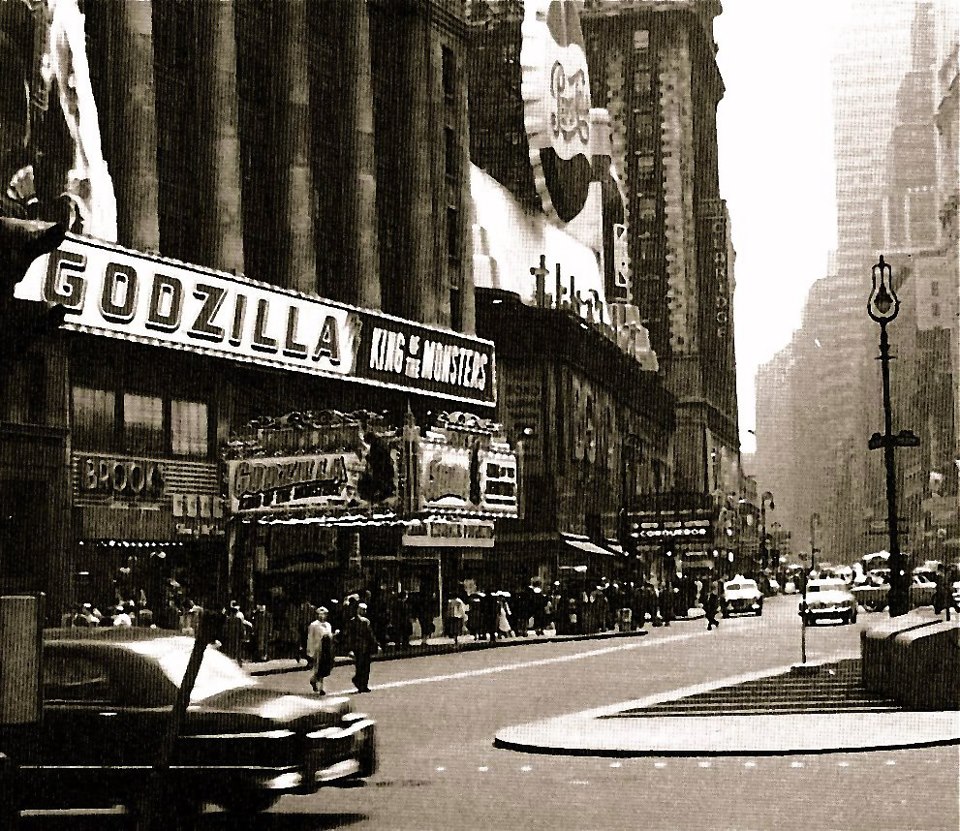
Released on October 24, 1954, in Nagoya, Japan, was producer Tomoyuki Tanaka and director Ishiro Honda's "Gojira". Set around the tragic love story of "Emiko Yamme", "Dr. Daisuke Serizawa" and Coast Guardsman "Hideto Ogata" is the tale of a prehistoric creature revised by the H-Bomb.

Had the above paragraph been all there was to the plot of "Gojira". It would have sounded similar to Ray Harryhausen's 1953 "The Beast from 20,000 Fathoms". About a prehistoric dinosaur released from its Arctic hibernation by an Atom Bomb test. However, there was a strong anti-American message within Tanaka's and Honda's story. That went to the reason the American posters for "Godzilla, King of the Monsters" did not have producer Tomoyuki Tanaka's name on them and director Honda, became just "I. Honda".
On March 1, 1954 the United States tested an H-Bomb in what was code named "Castle-Bravo" on Bikini Atoll.

On the same day the Japanese tuna fishing boat the "Daigo Fukuryu Maru (The Lucky Dragon #5)" wasn't "lucky" and was down wind of the Bikini Atoll. The crew was exposed to intense radiation.
Below testing the tuna from the "Daigo Fukuryu Maru".and one of the 23 crew men after the fishing boats return to Japan.

Tomoyuki Tanaka, screenplay writer Takeo Murata and director Ishiro Honda used the above two events as the basis of "Gojira", but also turned their title character into an allegory of the two Atomic Bombs dropped, by the United States, on Hiroshima and Nagasaki.
In short the 1954 feature is both an anti Nuclear Race plea and an indictment of the United States for using Atomic Weapons to end the war upon, what the Japanese considered, an already beaten enemy.

The running time of the original 1954 "Gojira" was 98 minutes, but after editing footage out and adding new major footage of Raymond Burr and Fresno, California born Japanese American actor Frank Iwanaga. The English language version, "Godzilla, King of the Monsters", has a running time of 80 minutes. Indicating how much of the original production had to be removed to change the film's tone.

The plot was cleansed of any scenes, or dialogue that could be considered anti-American. Instead of the allegorical Atomic Bomb that was "Gojira" destroying modern Tokyo. "Godzilla" had become the typical 1950's American giant monster on the loose. The producers have substituted the story line of the hibernation in the arctic ice of Ray Harryhausen's "Rhedosaurus" for "Godzilla's" in an undersea cavern off of "Odo Island". Instead of the clear relationship to the "Castle-Bravo" test awakening "Gojira". "Godzilla" is awaken by an earthquake that was caused by an H-bomb test. The scene of "Dr. Kyohei Yamane" addressing the Japanese Diet. His explanations of "Gojira's" creation and the arguments put forth by the Diet members is almost nonexistent in "Godzilla". .
Instead of the clear impression that "Gojira" is the allegorical "Castle-Bravo" H-Bomb. "Godzilla" is said to have death rays on the movie posters. Although we never see flames coming out of its mouth and the scenes of his nuclear breathe remain. In "Godzilla" Raymond Burr's "Steve Martin" somehow implies he is actually breathing fire.
Instead of the complete struggle, edited out, of "Dr. Serizawa" over the good intentions of scientific research and the resulting inventions for mankind vs the possible evil those inventions might also produce. Substitute the "Manhattan Project" and the creation of the first "Atomic Bomb" for "Dr. Serizawa's" "Oxygen Destroyer".
The 1956 film reduces "Dr. Serizawa" to an obsessed scientist who has created the "Oxygen Destroyer" and is oblivious to everything around him including the young women he loves "Emiko Yamane".
One could argue over these differences, but I want to move to "Gigantis, the Fire Monster". Which was released in the United States on Thursday, May 21, 1959. Like "Godzilla, King of the Monsters" I saw this film the following Saturday at the still boarded up Reseda Theater, in Reseda, California.
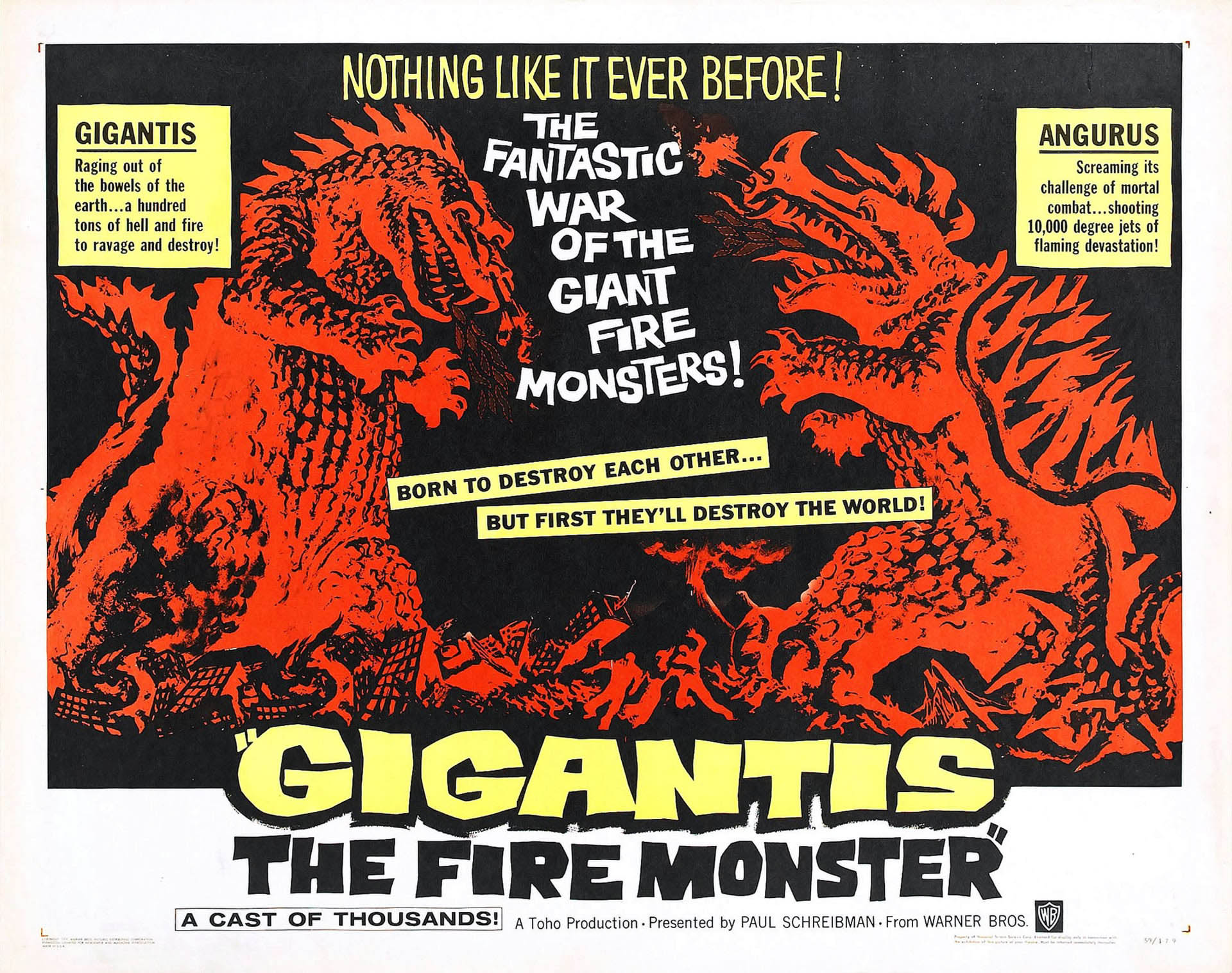
After seeing "Gigantis, the Fire Monster" those viewers familiar with "Godzilla, King of the Monsters". That recently was seen on the syndicated television program "Million Dollar Theater". Where asking themselves, if this be another "Godzilla" movie with a wrong name?
Many fans across the country actually wrote to their local film critics and many others, myself included, wrote to the growing authority on Science Fiction and Horror motion pictures "Famous Monsters of Filmland".
Not only did the magazine confirm our suspicions, but we learned that "Godzilla, King of the Monsters" wasn't an American movie at all. It was a re-edit of a Japanese film from 1954 entitled "Gojira".
Later, in 1959, I was able to see both the original Japanese language version of "Gojira" and with it the original Japanese language sequel, "Gojira's Counterattack", at the Nuart Theater in Santa Monica, California.. The sequel had originally been released in Japan on April 24, 1955.
"Gigantis, the Fire Monster" would eventually be re-titled "Godzilla Raids Again". This was after Toho Studios was given the rights to it and that name would also be applied to the original 1955 sequel.

In 1959 "Gigantis, the Fire Monster" had been released by Warner Brothers. The story behind the acquisition of the Toho movie and resulting Warner Brothers release is interesting in itself. It begin with a small company that dubbed foreign films for American release. That company acquired the rights to "Gojira's Counterattack" and planned to use the original production as part of a syndicated group of foreign Science Fiction and Horror films to compete with the syndicated "Shock Theater".
The film arrived accompanied with the suits worn by the Kaiju actors, but two things happened. The company closed down and the suits disappeared. However, before this happened Warner Brothers stepped in on the project.
Warner Brothers was developing a story by Ib Melchoir called "The Volcano Monsters". Instead of producing an expensive new motion picture as Melchoir's original screenplay required. He was now instructed to turn "Gojira's Counterattack" into "The Volcano Monsters".
Both the original and re-edit of the Toho production open with two pilots, for a fishing company, discovering two dinosaurs fighting on a small island. In both the original Toho version and the Americanized version. "Dr. Kyohei Yamane", the actual tie in to the 1954 "Gojira", explains the origins of the dinosaurs to the officials of Osaka. However, here is also were the main difference in the two versions comes.
In the Toho original:
The Osaka officials learn that one of the two dinosaurs is believed, by "Dr. Yamane", to be of the same species as the creature that destroyed Tokyo in 1954. He even shows film footage of that 1954 attack for comparison. "Yamane" is directly asked about using the "Oxygen Destroyer" and informs the Osaka authorities that "Dr. Serizawa" died releasing it. There is no way he knows of stopping this new "Gojira".
In the Ib Melchior story:
The Osaka officials are told the story of the dinosaurs creation related to a prehistoric volcano. There is no mention of either the 1954, or 1956 motion pictures and this very badly made footage replaces those from the 1954 film.
One point in favor of Ib Melchior's story to that of Shigeaki Hidaka for Toho. As ridiculous as the volcano origin story sounds. It is an origin story. In Hidaka's story the only origin the audience is given is, as I mentioned above, that the "Gojira" in this story is of the same species as the original creature. Shigeaki Hidaka never explains did this creature come from the same cavern off of Odo Island as the 1954 original, or how it has a nuclear breathe? Did "Angurus" come from the same location, or a different one? In fact having a second Kaiju begs the question are there more? None of this is really explained.
One of the American producers Paul Schreibman explained the name change from "Godzilla" to "Gigantis" in a 1998 interview with writer Steve Ryflie for his book "Japan's Favorite Non-Star: The Unauthorized Biography of Big G":
We called it 'Gigantis' because we didn't want it to be confused with 'Godzilla' [who had clearly been killed irreparably by the oxygenator].Of course Schreibman overlooked the dialogue and story from the actual sequel explaining that this 'Godzilla" is just of the same species.
The original Toho production runs 81 minutes and the American version runs three minute less at 78. Once again raising the question. What was cut out to permit the inserting of the "Volcano" sequences and still ending up with a shorter picture?
One answer is the story of "Koji Kobayashi". His death at the end of the picture is much more tragic in the original Toho production. We learn more about his unseen girlfriend and the loneliness of "Kobayashi" that her love has changed. His story was almost eliminated completely in the American version, but partly remained because of some footage required to move the new plot..
One problem with dubbing a Foreign film into English is matching the lip movements. "Gigantis, the Fire Monster" contains one of the classics. According to George Takei there is a scene that a popular Japanese swear word was used by the leading actor. To match his lip movement for the English dub the phrase:
Banana Oilwas used,
On August 11, 1962 Japanese audiences first saw "Kingu Kongu Tai Gojira". The American version "King Kong vs Godzilla" premiered on Wednesday, June 26, 1963. I saw that version on the following Saturday at the "Majestic Theater" in Santa Monica. Today it's a small legitimate theater and concert venue.
However, on Sunday, I went to the "Toho LaBrea" theater on La Brea Boulevard and Wilshire Boulevard to see the subtitled "Kingu Kongu Tai Gojira". What a difference between the two motion pictures.


There have been many discussions and disagreements over the size of "King Kong" in the motion pictures. The following is a drawing made by Willis O'Brien. Its not for the original 1933 production, but as part of a story board to sell his 1961 screenplay "King Kong vs Frankenstein". In which "King Kong" lives and protects the animals of Africa and "Dr. Frankenstein" is creating a giant gorilla that would be brought to life by electricity.

Above "Frankenstein's" creation is on the left and O'Brien's new "King Kong" on the right of the man in the middle.
The problem facing O'Brien was money./ He was about to make a similar mistake as he had with producer Irwin Allen for 1960's "The Lost World". Allen had only wanted Willis O'Brien's name associated with his remake of the stop motion animator's 1925 version of Sir Arthur Conan Doyle's novel. The trusting O'Brien discovered, after signing the contract, that stop motion animation was out and live lizards in. He was listed fourth under the credits for the "Visual Effects Department" as an "Effects Technician".
For turning his screenplay "King Kong vs Frankenstein"into a feature film. Willis O'Brien approached producer John Beck, not the actor of the same name, and signed a contract to use his story. However,. Beck, had screenplay writer George Worthing Yates do a rewrite and the new story became "King Kong vs Prometheus". As with Irwin Allen! Willis O'Brien thought he would be doing the stop motion animation, but John Beck knew stop motion animation was both costly and time consuming and looked for an out..
Beck read a short notice in the Hollywood Trade Paper "Variety". Toho Studios planned to bring back "Gojira", but had not yet finalized a story line. John Beck went to Japan and sold the rights to "Frankenstein vs Prometheus" to the studio with the option to distribute the American version of the finished motion picture..
There would be a lawsuit filed by Willis O'Brien alleging that John Beck had no right to rewrite, or sell his screenplay. He also claimed the rights to the character of "King Kong" were his alone. A secondary lawsuit would be filed by the estate of Merian C. Cooper. Cooper had always claimed he owned the character of "King Kong" and his estate his estate not been consulted by John Beck, or Tomoyuki Tanaka. RHO Studios claimed they owned the character of "King Kong" and backed Toho. However, this part of the story is for another time.
John Beck had expected too make a straight English language dub of "Kingu Kongu Tai Gojira", but what he saw wasn't the movie either screenplay should have produced.
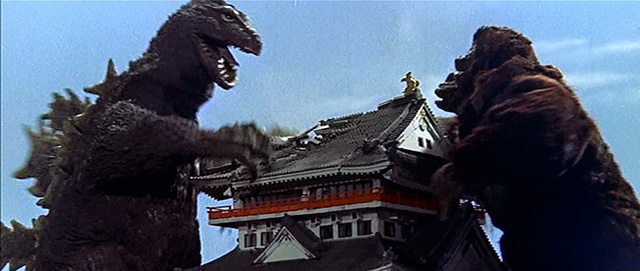
In the 1960's Japan was going through a change from the traditional Japanese Business model to the American model. The screenplay by Shinichi Sekizawa made fun of the "New Japanese Businessman".
The original film starts with a view of Earth from space and a narrator asking a question about human survival, if the planet stopped spinning on it's axis. Then the audience discovers this is part of a television science program "The Wonderful World of Science". Switch to the head of "Pacific Pharmaceuticals" "Mr. Tako" upset with his advertising department having his company be the sponsor of a science program that nobody ever watches. "Mr. Tako" is shown as a comic parody of the new modern Japanese businessman by Sekizawa.
Then the story switches to the American nuclear submarine "Seahawk" that spots a glowing area within an iceberg. Switch again to "Pacific Pharmaceuticals" employees "Osamu Sakurai" and "Kinsaburo Furue". They have completed another live commercial that "Mr. Tako" is complaining about. The two are discussing ways to improve viewership on the science program. They wonder if something will come from a meeting with a noted scientist for the following day.
Below is the meeting as "Mr. Tako", in the middle, with "Sakurai" and "Furue" listen to the scientist speaking about the berries he discovered on "Faro Island". These berries appear to keep the natives completely healthy without disease. "Mr. Tako" is not completely listening until the scientist also mentions there is a giant native God that protects both the berries and the natives. "Tako" decides to send "Sakurai" and "Furue" to "Faro" and bring back the monster God. So he can use it solely for a one time publicity stunt to raise the company's television ratings.

Switch to "Osamu Sakurai's" apartment that he shares with his sister. Her boyfriend is there and demonstrates a thin wire that is stronger than steel. Switch again to a party being given by "Mr. Tako" to publicize his expedition to "Faro Island". Switch again to the "Seahawk". The audience watches as it is damages by falling ice blocks causing flooding to the submarine and creating a fire.
The film now switches to the ship carrying "Sakurai" and "Furue" and their arrival on "Faro Island" and the meeting with the natives. This is followed by a short sequence between "Osamu's" sister and her girlfriend and then we have the appearance of "Gojira".
The dialogue in the original Japanese version confirms that this is the same "Gojira" seen in the 1955 motion picture. Next "Gojira" attacks an arctic military base.

Above the second "Gojira"in 1955 and below the third version in 1962, but in the story the same Kaiju as above.

John Beck's "King Kong vs Godzilla" was released, as I said, on June 26, 1963. Beck had attempted to change the story line into a straight monster vs monster movie. This meant removing all of the parody of Japanese business and somehow inserting a more dramatic story.
To change the story he hired writers Paul Mason and Bruce Howard. This was Mason's second writing assignment. This was Howard's first motion picture, after three short subjects, and both men would write for television afterwards.
For a musical score, as Universal Studios would release the movie, John Beck took music composed for the scores of different Universal motion pictures. You can hear pieces from "The Creature from the Black Lagoon", "Frankenstein Meets the Wolfman", "The Monster That Challenged the World" and even the James Stewart western "Bend in the River". Along with at least another six movies.
Then to increase the final fight sequence between "Godzilla" and "King Kong". John Beck inserted the Earthquake village scene near the start of the motion picture "The Mysterians". He also used footage of "The Mysterians" mother ship, sen below on the right, as a communications satellite and if you look closely in Beck's release. You will see the flying saucers coming and going to it.

John Beck basically removed the opening of the original Toho production. The Earth sequence was given new dialogue, but there was no follow up about it being part of a television show. The scenes of "Sakurai:" and "Furue"at the television station were removed as well as the publicity party. The destruction of the "Seahawk" appeared to be from the emergence of "Godzilla" in the iceberg and there was no attack on the arctic military base.
To move the story in the direction John Beck wanted. He created an American International television reporter and a paleontologist to discuss "King Kong" and "Godzilla" throughout the film. Along with a Japanese reporter to speak to the battle between the two Kaiju.

Above the American reporter, at the start of John Beck's re-edit, telling his television audience about the Berries found on "Faro Island". Below, the reporter and the paleontologist discussing the sizes of "King Kong" and "Godzilla's" brains. The pea size marble, in the reporters hand, is suppose to represent the size of "Godzilla's" brain. As compared to the size of a gorilla's in the skull the paleontologist holds. Making "King Kong" a thinking mammal and "Godzilla" a reactionary reptile in Beck's revised screenplay, There are no such narrators for the viewing audience in the original motion picture.
The original Toho release has a running time of 98 minutes, but even with the additional footage of these two characters in the John Beck version. The North American English language cut is seven minutes shorter at 91 minutes.
Beck retained the scene of the American helicopter looking for the "Seahawk" and witnessing "Godzilla" coming out of the iceberg. The pilot still makes the statement "It's Godzilla", but how in the world he knew "Godzilla" is an unanswered question. As the screenplay for John Beck's dub never explains how anyone knew about "Godzilla", because his version, of the Toho original, is unrelated to either 1956's "Godzilla, King of the Monsters", or "Gigantis, the Fire Monster". An example of one of the holes in the screenplay.
Another example of the problems Beck had with the original screenplay. Occurs when "Sakurai:" and "Furue"first interact with the "Faro Island" natives. This is the scene with the cigarettes and transistor radio. In the Toho production the scene parodied how Japanese business now sells to the average Japanese consumer, but John Beck couldn't cut it out to maintain story continuity and it appears as a comedy sequence in a film that otherwise is suppose to be taken seriously.


As I mentioned the final battle wasn't as exciting as John Beck wanted and he added footage to it. However, the ending of both versions is the same. Neither "King Kong", or"Godzilla" is a clear winner. "Kong" is seen swimming back to "Faro Island" and "Godzilla" is not see after the two rolled off the cliff in the water. However, during the closing credits in the Toho original. The audience hears "Gojira's" roar and knows he will back.
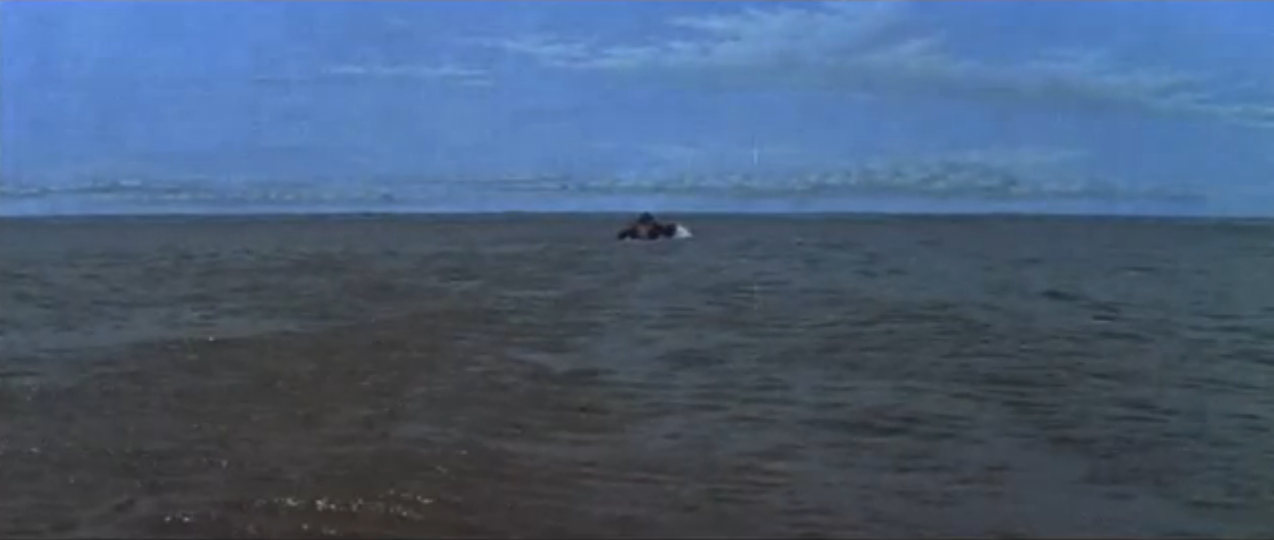
When "Gojira" turned 30 Tomoyuki Tanaka wanted to bring him back. The movie was also entitled "Gojira" and was released in Japan on December 15, 1984.

This was to be a both a major production, but also a rewriting of the Showa Era Kaiju. The screenplay was given to Shuichi Nagahara to write. One of the first things he did was to ignore the 1954 original screenplay. The audience is told this "Gojira" attacked and destroyed Tokyo in 1954, but there is no "Oxygen Destroyer" and he just disappears for 30 years.
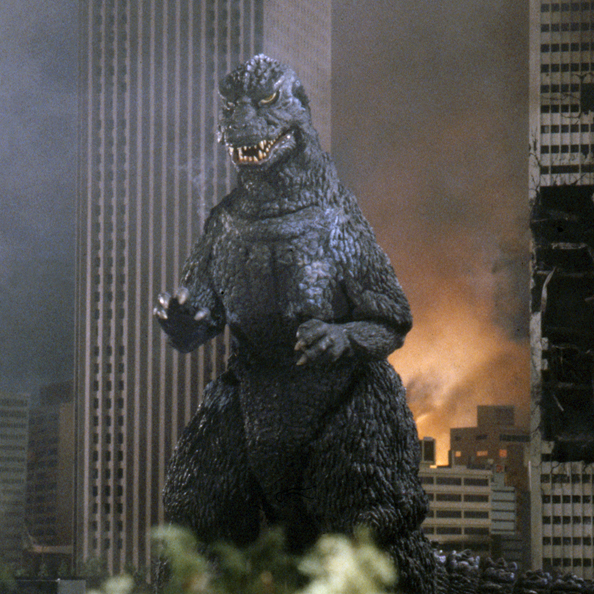
The Toho motion picture is also known as "The Return of Godzilla", or "Godzilla 1984". Both titles having English language dubs by "Toho International". Not to be confused with "Godzilla 1985".
The pictures characters, if they were alive in 1954, fully remember the attack on Tokyo by "Gojira" and his disappearance afterwards. The film opens with a storm at sea and the fishing boat "Yahata-Maru" getting caught in it near "Daikoku Island". The island starts to erupt and the crew sees the shape of some giant animal and hears its roar.
After the storm has subsided and the coast guard is looking for the missing fishing boat. Reporter "Goro Maki" in his own sailing boat, comes upon the "Yahata-Maru". Boarding her he finds a dead crew seemingly drained of blood from giant sea louse. He is attacked by one, but suddenly saved by the only survivor "Hiroshi Okumura". The two are rescued and, later, while looking at some photographs realize the ship was attacked by "Gojira". It is also established that the sea louse came off the now loose kaiju.
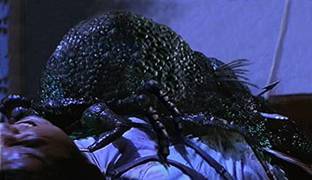
"Professor Makoto Hayashida" has been investigating "Gojira", because his parents were killed in 1954 by it. He also believes in the theory that dinosaurs are related to birds. An interesting plot point and mostly unknown to the general public until author Michael Crichton published his novel "Jurassic Park" in 1990.
"Hayashida's" assistant is "Hiroshi's" sister "Naoko" and a love story will develop between her and "Goro". A Russian submarine is attacked and destroyed. The Russian's believe it is the Americans and the United States claims otherwise. It was, of course, "Gojira", and tensions rise between the two countries with Japan in the middle.
"Gojira" is heading toward Japan and the cabinet meets to discuss the island's defense against it. At this point the Prime Ministers and others have mentioned the original attack upon Tokyo that they all remember. It is decided to use the "Super-X" flying tank against "Gojira".
Meanwhile, "Professor Hayashida", "Hiroshi", Naoko" and "Goro" have noticed that "Gojira" was lured away from feeding on the "Ihama" nuclear power plant reactors by a flock of birds. The Professor believes that confirms his theory about the relationship of dinosaurs to birds. He forms a plan to lure "Gojira" to "Mt. Mihara" an active volcano.
In the end after "Gojira" has destroyed Tokyo, once again, and the "Super-X" along with the city. "Gojura" is lured into "Mt. Mihara" by the bird sounds "Professor Hayashida" was able to reproduce. It is a said sequence with the possible death of "Gojira" in the lava within the crater.
On Friday, August 23, 1985 New World Pictures released "Godzilla 1985". This was a re-edited version of Toho's "Gojira". I saw it the following day at the now forgotten Van Nuys Theater, on Van Nuys Boulevard, in Van Nuys, California.
The movie had four things different from the previous years original Japanese production. These were Raymond Burr, Dr. Pepper, a direct tie in to 1956's "Godzilla, King of the Monsters" and a very political Anti-Soviet Union story line.
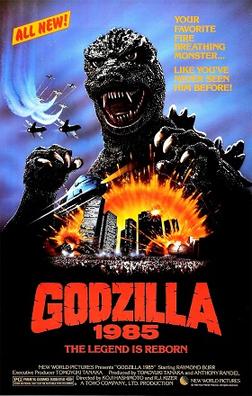
The new screenplay was credited to producer Anthony "Tony" Randall and Lisa Tomei. An Emmy Winning visual effects artist later. Who later in her career worked on films such as 2007's "Zodiac" and 2011's "The Girl with the Dragon Tattoo". In a June 26, 2018 interview for "Vantage Point Interviews".
https://vantagepointinterviews.com/2018/06/26/rewriting-godzilla-lisa-tomei-on-americanizing-godzilla-1985/
Ms. Tomei stated:
The translated pages of the script were challenging to decipher, at best. My first few times through the film, I felt the story had no cohesion. Some interesting references, but mostly it seemed to be disconnected nonsense. Tall buildings, birds migrating — brief symbols with little or no connection to anything one could glean from the action, the subtitles, or the English translation of the script. I suspect that there were either better allusions or cultural cues for the Japanese in the original. Like poetry, it was too subtle for the American viewer. Things like the angry homeless man still escape me.
She was made aware that Raymond Burr signed to reprieve his role of "Steve Martin", but she changed his name to "Steven Martin". This was to avoid confusion with the "Saturday Night Live" comedian Steve Martin. On Burr's character Lisa Tomei stated:
Initially I was on my own. Having said that, I must credit Tony for having the idea of creating the new scenes, lending a tie-in for American audiences. I saw the insertion of Raymond Burr scenes as an opportunity to explain much of what I felt was missing from the Japanese script. He was, in a sense, the other voice of the professor character, respectful and somewhat compassionate toward a product/victim of human error, much as global warming might be viewed in our day.

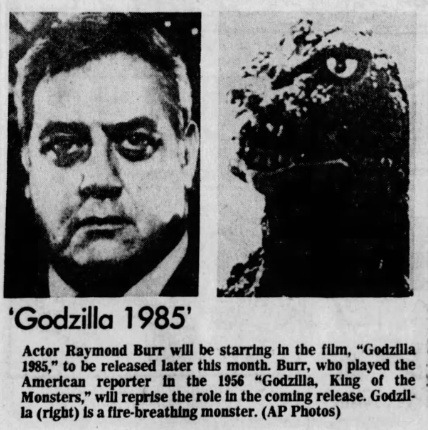
I mentioned "Dr. Pepper". The drink was one of the major backers of the American version of the 1984 motion picture. The product placement for the drink was somewhat over the top and a little too obvious and distracting at times.


However, to promote the picture there were some fun "Dr. Pepper" commercials running on television.

As Lisa Tomei mentioned in my second quote. Her screenplay reminded those viewers, unaware of the 1956 motion picture, about what happened to Tokyo as "Steve Martin" viewed it. In this film "Steven Martin", the only American witness to the original attack, is called by the Pentagon to assist them in understanding what is happening in Japan with this NEW "Godzilla". Tomei's screenplay makes it clear this is another "Godzilla" similar to what happened with the 1955 Toho sequel.
The audience sees "Steven Martin" explaining the history of "Godzilla" by showing scenes from the 1956 motion picture. The Pentagon's "General Goodhoe" and his aide "Colonel Raschen" come across as just plain dumb. As they seem not to be able to figure out for themselves anything they're watching on a live television feed from Japan of scenes from the original Toho production. The entire American scenes take place in a Pentagon War Room and there is zero interaction with Japan. However, we do have ":Colonel Raschen" over dosing on "Dr. Pepper's" product placement as seen above.
I mentioned the Anti-Soviet Union slant to the screenplay. There is a sequence involving a Soviet ship in Tokyo Bay that is connecting to a satellite with nuclear missiles . My copy of "Godzilla 1985" is the Japanese release of the motion picture.
As my readers should know. When a Foreign language is spoken in a movie. Unless the viewer knows the language they depend upon entirely upon the subtitles to explain what is being said. Sometimes subtitles can be misleading. My DVD has two sets of subtitles when the Russians speak. One set is from the 1985 release and the other is from the original 1984 film, but both appear together as the Russians speak their lines.
The subtitles are different in wording and especially in meaning.
As seen in the United States the Captain of the Russian ship deliberately prepares to launch a nuclear missile from the orbiting Russian Satellite. We know this, because those 1985 English subtitles tell us so. "Godzilla" attacks the harbor and the Russian Captain dies as he sends the signal arming the satellite and the countdown begins.
Same sequence in the Toho production. "Gojira" attacks the harbor initially and causes a short circuit in the wiring of the computer controlling the satellite. The subtitles tell us that the Russian Captain is not deliberately starting the countdown, but attempting to stop it. He dies before this can be done and the countdown continues.
Also on my Japanese release of "Godzilla 1985". There are a few seconds of an extended scene of the Japanese Prime Minister receiving apologies over the missile launch from the Soviet Union's Ambassador. In both films the American's are able to destroy the nuclear missile in space.
The original 1984 "Gojira" had a running time of 103 minutes. "Godzilla 1985" only runs 87 minutes. Like 1956's "Godzilla, King of the Monster". The viewer sees new footage with Raymond Burr, but should question what is still missing?
JU JIN YUKI OTOKO
A question often asked is why didn't Ishiro Honda direct the sequel to 1954's "Gojira". The answer was Tomoyuki Tanaka had him directing "Ju Jin Yuki Otoko". Which is known in English as either "Beastman Yukio", or "Mountain Snowman". There is a third name, but that is associated with the American version I will discuss shortly.
The original Japanese film was released August 14, 1955.

The original story was by Shigeru Kayama and the screenplay by Take Murata. The story is the second motion picture about a Yeti type creature made. The screenplay would become very controversial in Japan and Toho Studio's would pull the prints from theaters and, as one story goes, destroy all them, IF true we know finding a copy of the original picture is rare. While the American re-edit is not.
The story starts with a reporter awaiting the return of the survivors of a search party. Who had originally gone into the Japanese Alps six months before with their University "Professor Tanaka" for skiing. They carry a box containing the ashes of one of their friends and their tale is told in flashbacks.
As I just mentioned this was supposed to have been a skiing vacation for "Takashi Iijima:, his girlfriend "Machiko Takeno", her older brother "Kiyoshi Takeno" and their two friends "Nakada" and "Kaji"."Kaji" went ahead to the cabin of a mutual friend of the group named "Gen". "Kyoshi" says he's going to follow him there and the two will meet the others at an inn they all plan to stay at.
When the Professor and the remaining three students arrive at the inn. The manager "Matsui" informs them that a storm is coming and concern for "Kaji" and "Kyoshi"begins. Calling the cabin the manager can not get through. A girl named "Chika" comes into the inn during the building snow storm. She is from a native village in the alps. This visitor is not happy to find other people with "Matsui", because the villagers have cut themselves off from the rest of the world and have a secret.
The phone rings and "Machiko" answers it and through the earpiece comes the sounds of screams, a gun shot, and then the phone goes dead. While this is happening the audience sees a reaction from "Chika", as if she knows what happening, and the girl leaves while the others are occupied. There is no way the group can go to the cabin until the storm subsides. After it ends accompanied with the local police they now go to the cabin.
The rescue party finds "Gen" dead in the cabin and "Kaji's" body has been dragged into the snow. Both appear to have been killed by some type of animal. There are giant footprints in the snow, but no sign of "Kyoshi". Do to the snows it is considered, by the police, that no search can be made until after it melts. The remaining members of the skiing party return to Tokyo.
Six months later the group returns to search for "Kyoshi". This second half of the film has several converging plot lines.
Near the films conclusion the screenplay reveals that "Kyoshi" was found by the title character. Who is protecting his son, but took the injured student to tend to him as best as it could. "Kyoshi" eventually did die, but not before realizing that the father and son were the last of their kind and dying also. It is the ashes of "Kyoshi" that his sister was holding at the start of the story.

Another plot line has a man named "Oba" and his men hunting wild animals for the zoos and shows. "Oba" meets "Chika" and tricks her into revealing the location of the snowman the villagers considered their God. He goes after the snowman and his son. He captures the son and the father attacks. The son is killed by "Oba" and the snowman kills "Oba" in a very violent manner.
A third story line involves the village that the girl "Chika" is part of. Before the death of "Oba", "Takeshi", comes across both him and the snowman and is injured. "Chika" finds him and breaks the rules of her village by taking "Takeshi" there to tend to his wounds. The elder wants the young man killed, because he has discovered their secret of inbreeding.
"Takeshi" escapes and returns to the others. Meanwhile, the now enraged snowman destroys the village and later captures "Machiko".

It is during "Machiko's" rescue attempt that "Kyoshi's" remains are discovered in the snowman's cave. Along with a letter explaining what happened to him as the events are told in flashback.
"Chika", to amend for breaking the villages rules, helps to save "Machiko", but sacrifices herself in doing this. The snowman mortally wounded by "Takeshi" recognizes "Chika". The dying snowman grabs the girl and the two fall to their death.

The film returns to the reporter talking to the group ending the story.
Before I discuss the American version of this film. I want to return to the fact that Toho pulled all released copies of this film and may, or may not have destroyed them. This was because the film showed "Chika's" villagers living by inbreeding. Apparently there were many remote villages still in 1955 Japan and descendants of such villages living around the country. It is believed the reason Toho pulled the prints was mostly to avoid a backlash from groups like the "Buraku Liberation League". Whose members were descendants of "Outcast Communities".
On December 10, 1958, in the United States, the motion picture "Half Human" was released. The film starred American actors John Carradine, Russell Thorson, Robert Karnes and Morris Ankrum as a group of scientists discussing a Japanese skiing party's meeting with the Abominable Snowman and its son. They have the son's body to examine.

Basically the film is just very talky footage of the actors inserted as Carradine narrates scenes from the original Toho production. The poster for "Half Human" was obviously speaking to another motion picture than the one shot by Ishiro Honda and released three years before. It should also be mentioned that the original Japanese feature had a running time of 98 minutes. While, even with the additional footage of the American actors, "Half Human" has a running time of 61 minutes.

There has been stories of the original Japanese film being seen on American television in the 1960's and 1970's. I believe this could have been "Half Human", because over the years Toho has never released the original film. I first saw the Americanized film on television while in the Navy in the late 1960's. According to writers Steve Ryfle and Ed Godzisewski in their 2017 "Ishiro Honda: A Life in Films". Toho Studios has never released the complete 1955 motion picture on any form of Home Video and has no such plans.
Which brings me to the following still. Note the timing scale at the top. I purchased the complete Japanese original with English subtitles on a DVD. The entire film has the timing scale at the top and I speculate that this may be the film used to make "Half Human", but can not prove it.

DAIKAIJU BARAN
Released October 14, 1958 in Japan and directed by Ishiro Honda was "Daikaiju Baran".

A rare species of butterfly is discovered by two students in an area the butterfly should not be. This leads to sending researchers to the location the butterfly was seen near a large lake. The researchers arrive at a village, but the villagers will not speak to them and they leave. They are able to located the lake, but while looking for the butterfly the researchers are killed by something very powerful. Investigators are told, by the now talkative villagers, that the researchers died from the wrath of their "Mountain God Baradagi".
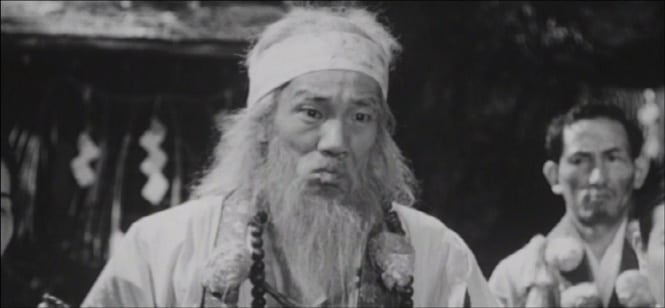

A company called "20th Century Mysteries Solved" pays for Reporters "Motohiko Horiguchi" and the sister of one of the dead researchers "Yuriko Shinjo" to accompany "Dr. Kenji Uozaki". They go to the village and are warned of the wrath of the God. The villagers are ignored by the three and finally at the lake they see "Baran".

Reports of the existence of the monster reach Tokyo and the Japanese Defense Force is mobilized. The village are evacuated for their safety and the military starts releasing toxins into the lake. Their plan is to force the monster out of the water, but the plan works too well. As the military discovers they can not stop "Baran" with conventional weapons.
As in 1954's "Gojira", "Baran", attacks Tokyo and hides within Tokyo Bay.
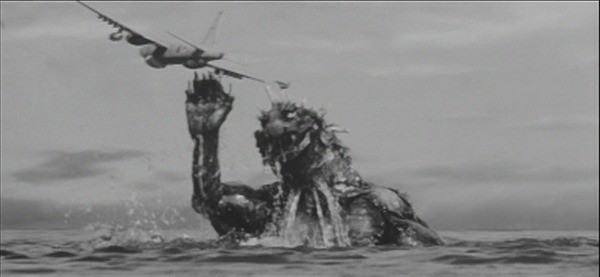
The Navy is dispatched and as in the previous film has no affect on the creature.

A special type of gun power is readied to be used on "Baran" and placed in one specific truck.While tanks are set up at the waters edge on an airstrip of Haneda Airport. The monster attacks and when its body is over the truck the explosives are set off. "Baran" falls over and the military rejoices on the kill, but it gets up and resumes the attack.
Flares are dropped on "Baran" and he is observed eating one of them. Immediately other flares are loaded with the special gun power and dropped over the creature. He eats two of them and one detonates inside his body and causes "Baran" to retreat to the sea. A short while later the second one explodes inside "Baran" and the military declares him dead.
This movie had a running time of 87 minutes. A shorten re-edited version for Japanese television, from Toho, was released with a running time of approximately 50 minutes.
On December 7, 1962 the American version of this picture was released as "Varan the Unbelievable". As with "Half Human" the film took footage from the Toho production and added major American scenes with actor Myron Healey. The new version was closer in comparison to what became "Godzilla, King of the Monsters" from the 1954 "Gojira". Than Ishiro Honda's original feature from 1958.
American's are experiments at a large lake in Japan. The experiments wake up a dormant prehistoric monster that attacks Japan and must be stopped. "Varan" is stopped at "Haneda Airport" as in the Toho production with slight modifications. This version had a running time of 70 minutes and advertised by Crown International Pictures as a made in Japan American film.


KAITEI GUNKAN
Depending upon the translator, the title of the Toho Science Fiction film is either "Undersea Warship", or "Submarine Warship".
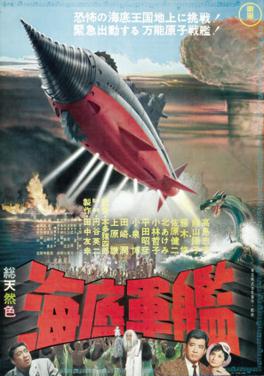
The original Japanese production was released on December 22, 1963 and was directed by Ishiro Honda. The screenplay was written by Shinichi Sekizawa and was based upon two novels: Shunro Oshikawa's "The Undersea Warship" and Shigeru Komatsuzaki's "The Undersea Kingdom".
The movie opens during a night photo, at the waters edge, by photographers "Susumu Hatanaka"and "Yoshito Nishbe" and their model. Suddenly a car drives by with two men in it. Very deliberately the car is driven off the dock and into the bay. Next a man in a a strange looking scuba diving suit appears and more divers are seen farther out in Tokyo Bay by the three on lookers.

The following morning "Police Detective Ito" is interviewing the two photographers on the dock. When a beautiful women is noticed by "Susumu". He sends "Yoshito" to find out who she is for another photo shoot. The girl turns out to be the daughter, "Makoto", of World War 2 submarine hero "Captain Hachiro Jingui". Whose entire crew went down in their submarine.
After the death of her mother, "Makoto", was raised by her father's friend and now retired "Rear Admiral Kusmi". "Susumu" and "Yoshito" follow a Taxi with the girl and the Admiral. The driver turns out to be the one from the car driven into the bay. The two photographers are able to stop the Taxi repeating the previous event.
Then, along with "Makoto" and "Kusmi", the two photographers learn that the Taxi driver is actually "Agent #23" of the "Mu Empire", before he runs into the bay and swims away.

The next day the four are with "Detective Ito" as a package is delivered marked "MU". Inside the package is a film that is played for several members of the United Nations. Watching the film are also "Susumu", "Yoshito", "Detective Ito" and "Makoto". The film reveals scenes of the undersea empire and contains a threat of war, if the surface world does not capitulate to "Empress Mu's" demands. Also, surprising everyone, is "Captain Jingui's" submarine on display.

It is also mentioned that "Jingui" must be prevented from completing his new submarine. Which indicates to the group that "Makoto's" father must still be alive.
"Admiral Kusumi" meets with other ex-military officers. They discuss the possibility of locating"Captain Jingui" and the fact, referred too in the "Mu film", that he must be building the submarine he was designing to help Japan win World War 2. The question becomes how to find him?
Meanwhile the police have arrested the man that has been stalking "Makoto" for days. However, he will not reveal who he is, or way he's a stalker. "Ito" takes the "Admiral", "Makoto" and the two photographers to the stalker's jail cell and it is revealed he is one of "Captain Jingui's" crew. The man agrees to lead all four to the hidden island base. While this conversation is going on. A strange reporter appears and says he has been following the group to get a story. It is decided to take him with them as a means of keeping things secret.
The group arrives at the secret island base to discover that it is being run like a Japanese naval installation from World War 2.


What the group further discover is that "Makoto's" father has built the "Gotengo". To her father, the super submarine was made for the rebuilding of the Japanese Empire. "Captain Jingui" is not interested in fighting "Mu". He is strangely very cold toward his daughter and after hearing her father's plans. The girl runs off in anger and is followed by "Susumu". As the two realize they're in love with each other. Unbeknownst to the two "Captain Jingui" has been watching and after "Makoto" leaves. The Captain is confronted by "Susumu" over his treatment of his daughter. After the other leaves the "Jingui" pulls out an old photo.

Later, the reporter is discovered to be a spy for the "Mu Empire". He blows up the dry dock containing the "Gotengo" and kidnaps "Makoto" and "Susumu". "Captain Jingui" now declares war on "Mu" as the Empire attacks the surface world with their fleet of submarines and other means.

While in "Mu" "Susumu" and "Makoto" meet other surface world prisoners. They once again see "Agent #23" and are shown the great God "Manda".


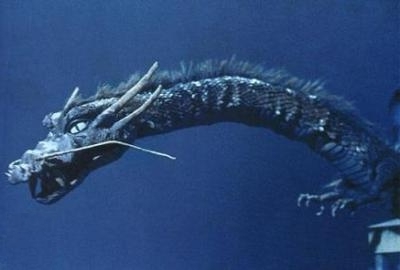
The battle starts by getting around "Manda" and rescuing the prisoners. It will end with the defeat of the "Mu Empire" and the "Empress" committing suicide to die with her people.

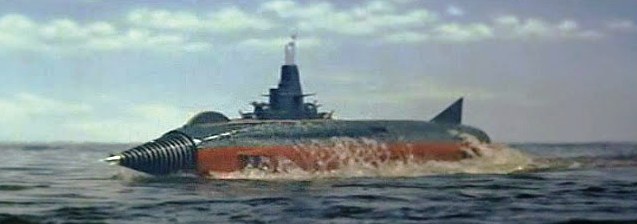

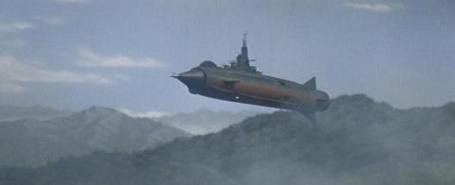
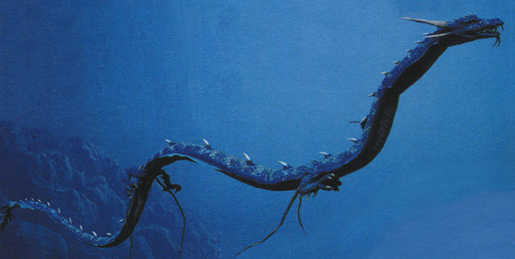
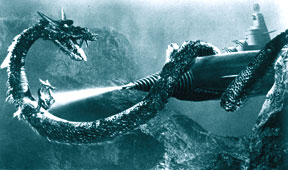




On Thursday, March 11, 1965, American International Pictures released "Atragon" and I was once again at the "Majestic Theater" to see it the following Saturday.


There were only a few changes made by American International and the overall running time wasn't much different. These changes were mainly made in the dialogue. The obvious one turning the "Gotengo" into "Atragon". The name was taken from the changes made by Toho International that I will explain shortly.
During the original Toho conversation about "Captain Jinguri" by retired "Admiral Kusumi" and the other ex-Japanese officers. The political nature of the secret operation the Captain was engaged in and original purpose of the submarine he was designing is raised in more detail. There is of course an anti-American feel to the conversation and a concern about what the United States would think about such a weapon. That tone was removed and the scene very minutely shortened by American International Pictures.
Also toned down was the nationalism and pride for Imperial Japan felt by the bitter "Captain Jinguri". The same type of nationalism were in the words of "Empress Mu" and her people, but this is almost non-existent in ":Atragon". The Empress of "Mu" and her subjects became just fanatics wanting to conquer the surface world. The "Mu" ruler has become much like the "Mu Queen" in Gene Autry's 1935 Chapter Serial "The Phantom Empire".
Toho International changed the films title for European release. The new title became "Atoragon" a contraction of the words atomic and dragon". Its used on the Spanish language poster for Spain seen below. That title was also used in Italy, but in France the picture was "Ataragon"..

Toho International also released an English language dub of their own, which I have, that is the complete original film. Only the dialogue is now in English.
SORA NO DAIKAIJU RADON
"Sora no Daikaiju Radon" in English as "Big Monster in the Sky Radon" or, "Great Monster in the Sky Radon" was released in Japan on December 26, 1956.

The motion picture opens with two miners "Goro" and "Yoshi" having a public fight. Things are broken up and the two men enter the mine with the rest of their shift. The alarm sounds and the mine shaft is being flooded. All the miners except the "Goro" and "Yoshi" are accounted for. Safety and tunneling engineer "Shigeru Kawamura" enters the mine and discovers the body of "Yoshi". Which is brought out and the doctor states he has been killed by an abnormally sharp object. "Yoshi's" wife and some others start to accuse the missing "Goro". This becomes a problem for "Shigeru" as he is in love with "Goro's" sister "Kiyo".

Two miners accompany a police officer into the flooded mine and one by one are pulled under the water and killed..

When their bodies are recovered. They appear to have been killed by the same weapon a "Yoshi". Afterwards "Yoshi's" widow verbally attacks "Kiyo", but other wives take her away.
As "Kiyo" and "Shigeru" are talking about all the accusations and the fact that "Goro's" body has not been discovered. Suddenly the two are attacked by a strange insect like monster. The two get away and the noise being made bring the police. Who are in the town investigating the growing number of deaths.


The insect is seen on the hillside and finally killed.
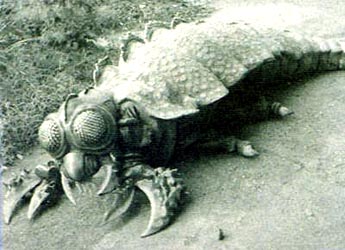
The following day the police, members of the now arrived military, and "Shigeru" enter the mine shaft. They discover the mutilated body of "Goro" and then are attacked by several of the insects.There is a cave in and Shigeru is trapped within.
Meanwhile, Paleontologist "Professor Kyouichiro Kashiwagi" identifies the insects as "Meganulon's" from millions of years ago.

Next a series of events take place. A jet at a military base reports a flying object doing impossible maneuvers at supersonic speeds and then something crashes into the jet. A couple celebrating their wedding are killed on Mt. Aso. Reports of the flying object is being reported at the same time in different parts of the globe.
A Earthquake occurs and wondering in the crater it caused is an amnesic "Shigeru".

When "Kiyo: shows him a birds nest with two eggs hatching. "Shigeru's" memory returns and we learn of the two "Radon's". He tells his story to "Professor Kashiwagi" and the military authorities. "Shigeru" claimed to have seen two eggs hatch and the giant flying creatures feed upon the "Megnulon's" and then the two creatures flew out of the mine shaft. "Shigeru" leads a group of military, police and "Kashiwagi" into the mine shaft and they find a piece of prehistoric shell.

The two flying creatures are now called "Radon". For a species of giant Pteranodon from the same prehistoric period as the "Megnulon's".The "Radon's" appear to be living in Mt. Aso, but now the two attack multiple Japanese cities and the military attempts to fight them.


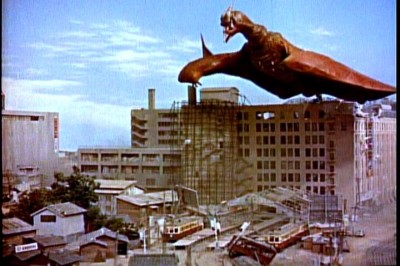
Unlike future versions of "Radon". The original, in this motion picture, not only has supersonic speed, but creates destruction with hurricane force winds coming from their mouths besides with their wings. Additionally the size of these creatures are far larger than in any other Showa Era feature.
The military set up rockets and other artillery on the sides of Mt. Aso. Their attack starts the dormant volcano to erupt. One of the "Radon's" is caught in the forming lava pool and the other joins its mate in death.
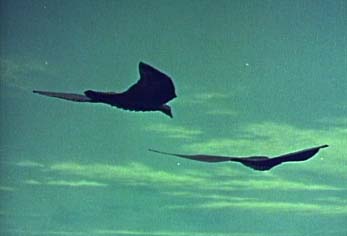
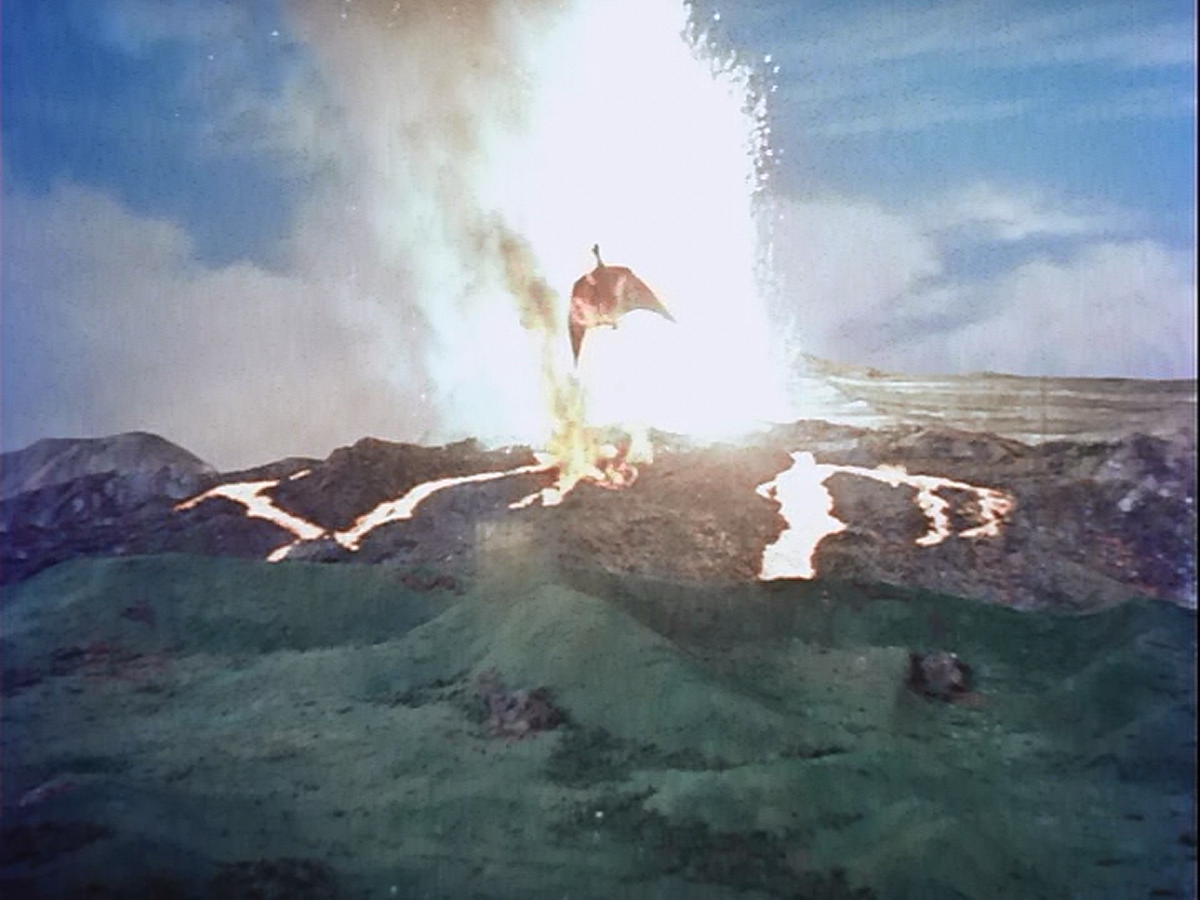
"Kiyo" and "Shigeru" witnessing their death are sadden by the end of these lovers out of time.
The original Toho film had a running time of 82 minutes. On August 6, 1957 the North American version, with a 71 minute running time was released. This version was entitled "Rodan the Flying Monster" on the original United States posters, but shorten just to "Rodan" on the movies opening credits.

Below is the United Kingdom poster.

The "King Brothers" changed the name of the title Kaiju by transposing the letters "A" and "O". 'RADON" was now 'RODAN".
Another change to this English language release was in the opening. Instead of showing the confrontation between "Goro" and "Yoshi". Dialogue mentions their previous fight. Instead the King Brothers showed an atomic bomb test and used dialogue about how the bomb might cause unknown affects on the world.
The first scene from the original production is basically "Shigeru" investigating the flooding in the mine shaft and discovering "Yoshi's" body and that "Goro" is missing. The explanation of the "Meganulon's" is not in this cut. A few small additional edits are made shortening the feature in the "King Brothers" release.
The last two motion pictures I want to discuss in this article are related to each other in the original Japanese versions, but not in the North American English language re-edits.
FURANKENSHUTAIN TAI BARAGON
The original Japanese feature is also known as "Frankenstein vs Baragon", "Frankenstein vs the Earth Monster" and "Frankenstein vs Baragon the Subterranean Monster". It was released in Japan on August 8, 1965.

Backstory for the original Toho production. Which is as complicated as the one for "Kingu Kongu Tai Gojira".
Tomoyuki Tanaka had always liked Mary Shelly's "Frankenstein" creation. He had seen the entire Universal series and the Hammer films up until 1961. Tomoyuki commissioned screenplay writer Takeshi Kimura, 1956's "Radon", 1957's "Earth Defense Force (The Mysterians)", 1958's "The Beauty and the Liquid People (The H-Man)" and 1960's "Gas Human Being #1 (The Human Vapor)" to write a sequel to that last picture. Tentatively the title in English would be "Frankenstein vs the Human Vapor" with a plot lifted partly from 1943's "Frankenstein Meets the Wolfman".
At the end of "Gas Human Being #1`". The dancer "Fujichiyo", loved by"Mizuno", "The Human Vapor" of this very good film is dead.
In this proposed sequel. The audience would see "Mizuno" discover the body of the "Frankenstein Monster" and make plans to revive it. So that he can learn the secrets of "Dr. Frankenstein" and bring his beloved back to life. Pre-production was cancelled prior to the screenplay being finished.
At the start of 1962 Tanaka purchased the above mentioned screenplay "Frankenstein vs Prometheus" from American producer John Beck. After the success of "Kingu Kongu Tai Gojira" Tomoyuki Tanaka went back to his love of "Frankenstein" and planned "Furankenshutain Tai Gojira (Frankenstein vs Godzilla)".
The treatment as originally written by Takeshi Kimura answered the question what happened to "Gojira"? After he fell into the Sea of Japan at the end of "Kingu Kongu Tai Gojira". The audience knew "King Kong" was swimming back to "Faro Island", but the movie left what happened to "Gojira" open.
Apparently this new picture was to have merged a part of both Kimbura's 1962 screenplay and the ending of Shigeru Kayama's 1955 screenplay. It would be explained that "Gojira" swam to the far North Sea and once again was frozen in ice.
However, the new screemplay starts with the heart of the original "Frankenstein Monster" becoming irradiated and actually forming cells and growing into a new and gigantic "Frankenstein Monster". The scientists are afraid the escaped monster might start eating people. So the Japanese Defense Force is sent to not bomb ice onto "Gojira", but to bomb the ice he is frozen within and free him. The hope being that "Gojira" will fight and kill the "Frankenstein Monster".
The planned ending had a natural disaster occur. This causes "Gojira" to fall into and disappear within a raging river. Giving an opening for the next film in the franchise, but a volcano erupts and the "Frankenstein Monster" sinks into the lava and dies.
Toho didn't like the logistics involved in filming this story and the cost to them that would result. The story was shelved and in April of 1964. The studio released "Mosura Tai Gojira (Mothra vs Godzilla)". Later, in September, American International Pictures would dub the film into English and release it as "Godzilla vs the Thing". Apparently AIP had no idea how successful, financially for Columbia Pictures, the 1962 release of "Mothra" had been in the United States and Canada. So they changed the giant Moth's name to the James Arness character from Howard Hawks' 1950 motion picture "The Thing from Another World". Which had just started to be show in syndication on American television.
In 1965 Tanaka found the funds to make his "Frankenstein" feature. It came from co-producing it with American Henry G. Saperstein and his "Henry G. Saperstein Enterprises".
During the 1950's Saperstein had become the merchandising king for television. He created tie in merchandise for shows such as "Lassie", "Roy Rodgers" and "The Life and Times of Wyatt Earp". Henry G. Saperstein also handled the merchandising for Colonel Tom Parker's client "Elvis Presley". In 1960 he purchased "UPA (United Productions of America) and started producing television cartoons of "Mr. Magoo" and created the "Dick Tracy" cartoon series, It was a kids version of "The Untouchables".
As "Godzilla" was out a new opponent for "Frankenstein" was created named "Baragon".

Kimura modified his screenplay to accommodate the removal of "Gojira" and the introduction of "Baragon". Otherwise the original characters were retained.
During World War 2 Nazi soldiers raid the laboratory of "Dr. Riesendorf". Who is experimenting on the heart of the "Frankenstein" monster. How he got the heart is not clearly explained. The Nazi's seize the heart and it is placed on a Nazi submarine that eventually transfers it to a Japanese submarine. That second submarine takes the heart to a scientist in Hiroshima for study.
_008.jpg)
_010.jpg)

On August 6. 1945 an Atomic Bomb is dropped from the "Enola Gay" on the city. To my reader please note that the original Japanese release of this picture was exactly 20 years and 2 days later and the impact that sequence must have had on the viewing audience.
It is now 15 years later a boy is rooming Hiroshima acting like some wild animal. The boy catches and eats rabbits and wild dogs.

American scientist "Dr. James Bowen" with Japanese scientists "Dr. Sueko Togami" and "Dr. Ken'ichiro Kawaji" are all made aware of the strange boy, but it will be a year later before they discover him hiding in a cave.
_018.jpg)
This happens when local villagers have cornered the outcast boy for robbing food and killing their dogs. The three scientists will take the boy to their hospital/laboratory. Only to discover that he seems able to resist radiation while others become sick and in many cases die from it.
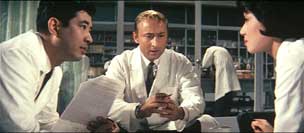
"Dr. Bowen" and "Dr. Togami" go and visit with a young girl named "Kazuko". She is dying from the radiation of the Hiroshima Atomic Bomb. Both doctors have become close to the girl and are upset that their research, at this point, can not save her and must watch her slowly die. Later while "Kazuko" is now confined to a hospital bed. They again visit her and shortly thereafter are informed of her death.
_015.jpg)
The former Naval Submarine Officer, "Captain Kawai", who brought the heart to Japan is now working at an oil refinery. One night a sudden earthquake apparently destroys the refinery. However, "Kawai" thinks he saw a giant monster appear in one of the quakes newly created fissures.
_021.jpg)
Meanwhile, the three scientists have discovered that with the boy is getting proper protein in his diet. He is growing at an alarming rate.
_019.jpg)
"Ex-Captain Kawai" has become aware of the strange boy from all the media coverage and visits the three doctors."Kawai" tells them the story of "Frankenstein's Heart". "Dr. Kawaji" goes to Germany to speak to the aging "Dr. Riesendorf" and comes back referring to the boy as "Frankenstein".
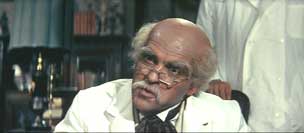
'Kawaji'" informs the other two scientists that "Riesendorf" speculated that if one of the boys limbs, such as an arm, were cut off. A new one would grow in its place. "Dr. Kawaji" wants to do just that, but "Bowen" and "Togami" won't let him. Meanwhile "Baragon" is attacking villages in the general area. The military and the villagers believe it is the "Frankenstein" boy's doing. but at the same time the now giant boy is under the care of the three scientists.
_030.jpg)
The giant boy has become very fond of "Dr. Togami", because she always shows kindness to him.
Several reporters are shown the boy, but their flash bulbs scare him and he breaks free.

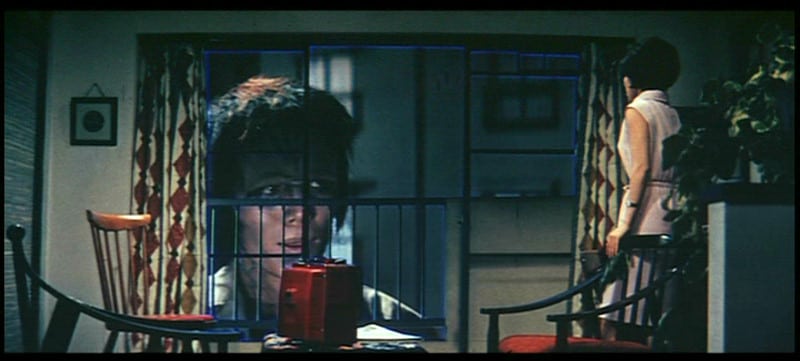
While the military hunt for "Frankenstein". The three doctors form their own search party and "Bowen" and "Togami" are shocked to learn that "Kawaji" plans to use grenades to blind the boy and kill him.. "Dr. Kawaji" wants to remove the "Frankenstein heart" along with the boy's brain for study.
Instead of finding "Frankenstein" "Dr. Kawaji" discovers "Baragon". Along with "Dr. Bowen" the two men attempt to stop the monster with the grenades. "Dr. Togami" is cornered by "Baragon", but then "Frankenstein" appears and the battle between him and "Baragon" starts. It is observed by the three doctors and the military.
_028.jpg)

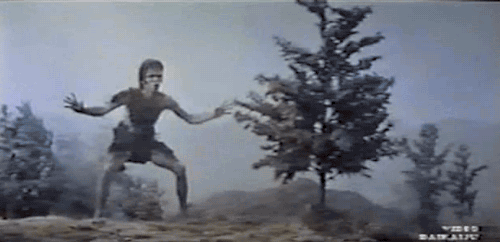
A forest fire is started and an small earthquake occurs and the two monsters disappear into the ground.
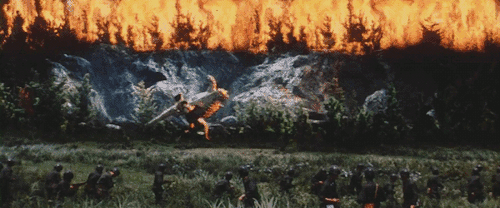
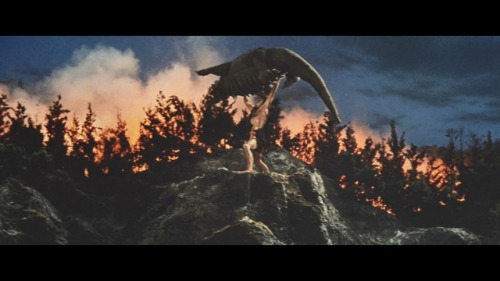
On July 8. 1966 the North American version of the picture now entitled "Frankenstein Conquers the World" was released.

I saw the picture while my aircarft carrier was in port at the Mayport, Florida Naval Base during the Vietnam War. The picture had a running time of 87 minutes. The entire movie was only two minutes shorter than the original Toho Production and that was because the scenes with the dying girl "Kazuko" were all but eliminated. This was to avoid any reference to what was still happening to the Japanese survivors of Hiroshima and Nagasaki..
Henry G. Saperstein had really liked the fight between "King Kong" and the giant Octopus in "King Kong vs Godzilla". He wanted "Frankenstein" to fight one also.
After principle shooting and post production had wrapped. Saperstein's insistence for such an ending involved bringing back the entire cast, building a new set for the fight scene and shooting it. When Henry G. Saperstein saw the final result he didn't like it and the North American version of "Frankenstein Conquers the World", except for the "Kazuko" scenes, remained the same as the Japanese release.
Here are two stills of that Octopus sequence. Which became the actual ending of some of the International releases of the film re-titled as "Frankenstein vs the Devil Fish". According to author August Ragone the film ends with the "Devil Fish" dragging "Frankenstein" to the bottom of the sea.
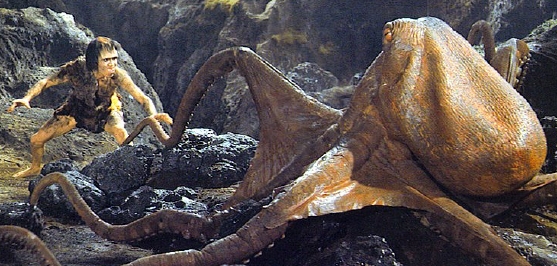

FURANKENSHUTAIN NO KAIJU: SANDA TAI GAIRA
The translated title of the original Japanese film was "Frankenstein's Monster: Sanda vs Gaira". This was Toho's DIRECT sequel to "Frankenstein vs Baragon" and was released on July 31, 1966.
I would actually see the Toho International English language version with French subtitles in Paris, France, the following year. While I was still in the Navy.
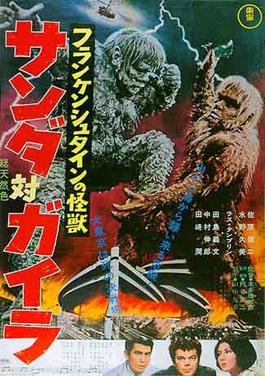
Once again Takeshi Kimura was the screenplay writer. As I mentioned this film was originally planned as a direct sequel to the previous picture with the same characters, but a slight problem occurred. Nick Adams, who had played "Dr. Bowen", was in love with his co-star Kumi Mizuno. Adams went back to the States and divorced his wife. He returned to Japan set to marry Mizuno, but found her engaged to another man. He backed out of the production and left Japan. Names were changed on the characters and "Dr. Bowen" became "Dr. Paul Stewart" with Russ Tamblyn in the role.Otherwise the basic sequel plot continued.
The film was also co-produced by Henry G. Saperstein.
You can't keep a giant Octopus down and this picture opens with a fishing boat being attacked by the Octopus Saperstein had created for the previous motion picture.

The Octopus is attacked by a green monster that will be called "Gaira". Who also sinks the fishing boat.


A survivor is found and speaks of a giant green "Frankenstein". The press pick up the story and enter "Dr. Stewart" and his assistant, apparently no longer an actual doctor, "Akemi Togami". The two once had found a baby "Frankenstein", but unlike the green one the sailor described, theirs was brown.
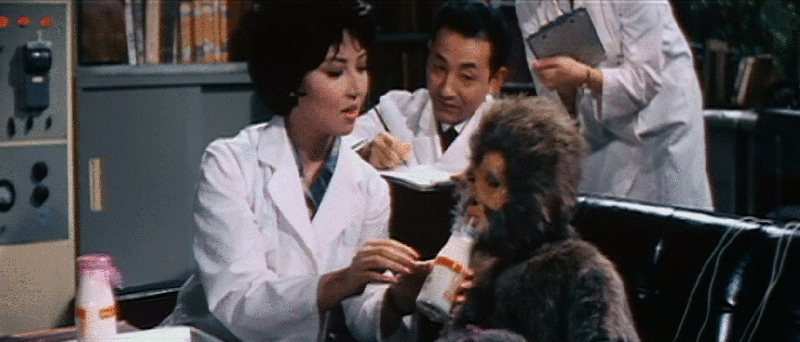
"Dr. Stewart" tells reporters that the "Frankenstein" they studied was gentle and would not attack anyone. However, another boat is attacked by the green "Frankenstein". A mountain guide reports seeing a brown "Frankenstein" in the Japanese Alps. All of this causes "Dr., Stewart" and "Akemi" to go to the Alps and send another team member, "Dr. Yuzo Majida", to a fishing village that was attacked by the green "Frankenstein".

"Dr. Stewart" and "Akemi" find giant footprints in the Alps, but no brown "Frankenstein". Who will be called "Sanda". While "Dr. Majida" gets samples of "Gaira's" tissue.
Meanwhile, "Gaira" comes ashore and attacks an airport. As he is eating a women, he took from the terminal, the sun comes out and he runs back into the water. It is believed by "Dr. Stewart" that "Gaira" does not like bright light which would possibly dry out his skin.



Studying the tissue of "Gaira" and that of the "Sanda", which they had since first finding him, it is determined that the two "Frankenstein's" are essentially brothers. Further that their father was the giant "Frankenstein Boy" whose cells grew into the brothers. Thus supporting "Dr. Riesendorf''s" theory from the previous motion pictures.
After "Gaira" attacks Tokyo the Japanese Defense Force wants to use military weapons against him including newly developed maser canons.
"Gaira" again attacks Tokyo, but this time at night. "Dr. Stewart" advised the military to have the residents turn on all their lights. The theory is "Gaira" will stay away from lighted areas associating the lights with the sun.
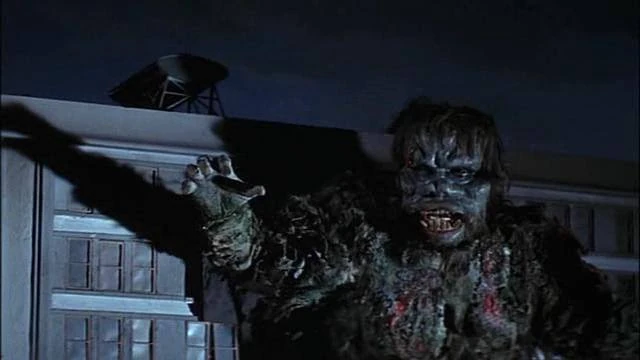
"Sanda" is discovered by "Dr. Stewart" and his team. This occurs after "Akemi" falls off a ledge and he rescues her. The team determine that "Sanda" is the "Frankenstein" they raised and is still very gentle and not aggressive like his brother.


While this is happening the Japanese Defense Force has been tracking "Gaira" into the same area "Sanda" has appeared in. The military finds the "Green Frankenstein" and attacks with the maser canons.
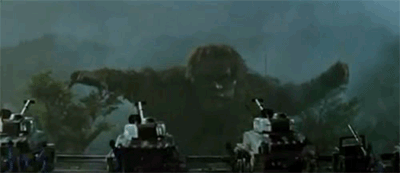

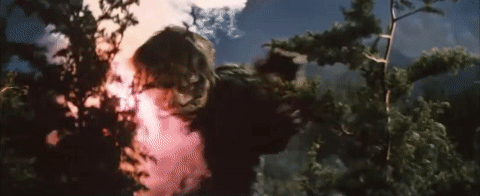
Suddenly "Sanda" appears, observes whats happening, and is able to pull "Gaira" to safety and away from the military.


The Japanese Defense Force now wants to go after both "Frankenstein's" and literally blow them up. "Dr. Stewart" attempts to get the military commander to understand that "Sanda" is still gentle, but is starting to distrust humans>
More importantly. "Dr. Stewart", "Dr. Majida" and "Akemi" are concerned that after such a battle the cells left on any object might grow into new "Frankenstein's". As these two were created. but the military and the press are skeptical about such a pronouncement.
"Gaira" attacks Tokyo once again and apparently is no longer afraid of the electric lights. At one point he has "Dr. Stewart" and "Akemi" corned in a building and "Sanda" appears to fight him.

The military opens up on the "Frankenstein's" as they enter Tokyo Bay to continue their fight.
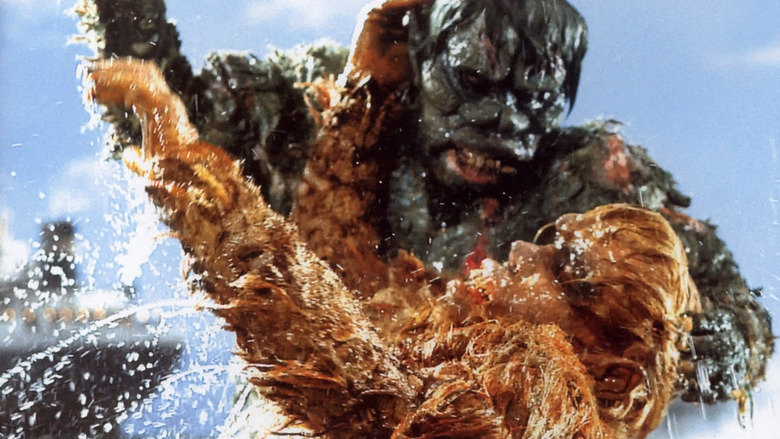
An aerial bombardment of the two is carried out and unfortunately it causes a volcano to erupt and when the smoke clears. Neither "Frankenstein" is seen.
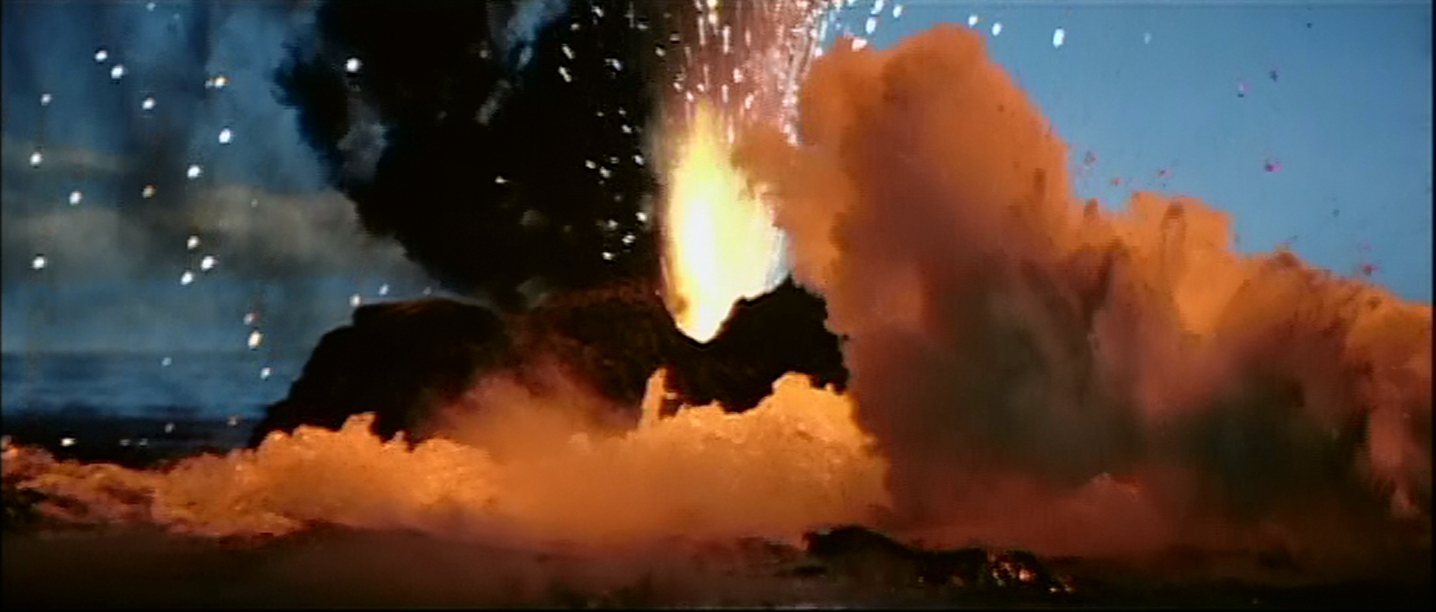
On July 29, 1970 the North American English language version "War of the Gargantuas" was released by Henry G. Saperstein. Not to be confused with the Toho International English language version I saw in Paris. As this was slightly changed and the other, as I mentioned, was a direct translation of the uncut Toho original.

While on the subject of dubbing. Apparently Russ Tamblyn's original dialogue track, he was the only actor speaking English during the Ishiro Honda's filming, was lost. As a result Saperstein had to have him come back and re-record his lines to make the North American version. However. the screenplay was also lost with his English lines and in the end. Russ Tamblyn had to ad-lib his entire role.
For those of my readers asking why they didn't just use the Toho International sound track? Like all the Japanese actors roles. Even Russ Tamblyn's voice was dubbed into English by Tokyo based "Frontier Enterprises".
One last piece of trivia. The original role of "Dr. Paul Stewart" was to be portrayed by Tab Hunter, but during pre-production he was replaced by Tamblyn.
The original Toho running time was 88 minutes, but the version my readers are most familiar with was initially shorten for American release. All references to even "Frankenstein Conquers the World" were removed. Especially the idea that "Sanda" and "Gaira" were, in a cellular way, related to the "Frankenstein Boy". The two were no longer referred too as "Frankenstein's", but now became "Gargantuas".
However, Saperstein had additional footage shot and the running time of the North American release was now 92 minutes, or four minutes longer than the Japanese unedited version.
Changes to many other Toho Studios films happened, even on a small scale, during the 1950's and 1960's.
"Uchu Daisenso (Space War)" was released December 26, 1959 in Japan. The North American English language version was released July 8, 1960 as "Battle in Outer Space". That English language version did not mention the film was actually a sequel to "Chikyu Boeigun (Earth Defense Force)" released December 28, 1957 in Japan and known in the United States as "The Mysterians". Which had been released May 15, 1959 in North America. On December 17, 1977 "Wakusei daisenso (Great Planet War)" aka: "The War in Space" was released in Japan. This is considered the third film in what is called a trilogy, but this third film was never released to theaters in North America.
One other example is "Mosura (Mothra)" released in Japan on July 30, 1961 with a running time of 101 minutes. It would be released in North America on May 10, 1962 with a running time of 91 minutes. One of the major cuts comes on "Infant Island" concerning the ancient tablets that are part of the natives religious ceremony to "Mosura". Each tablet is seen with a Japanese subtitle explaining what it says. These help the viewer understand the real reason "Mosura" is attracted to the airport at the film's climax by the markings on the tablet. However, other than the one tablet translated in the North American version. All the others and their meanings are left out.
As I said I grew up on the American releases and that formed the basis for a love of Japanese Science Fiction, Kaiju and Anime.


No comments:
Post a Comment